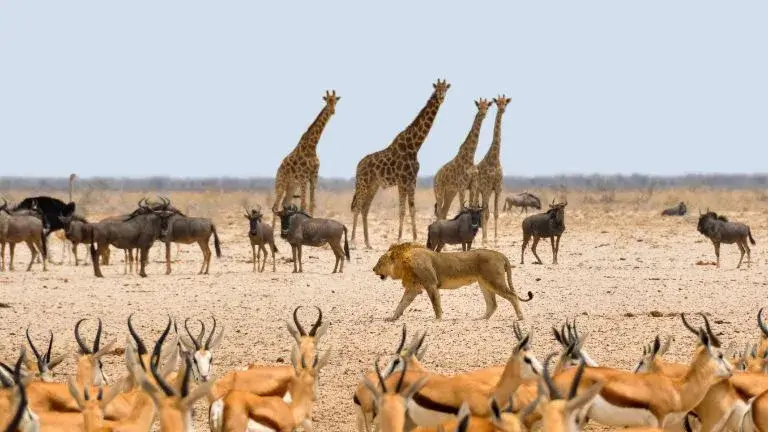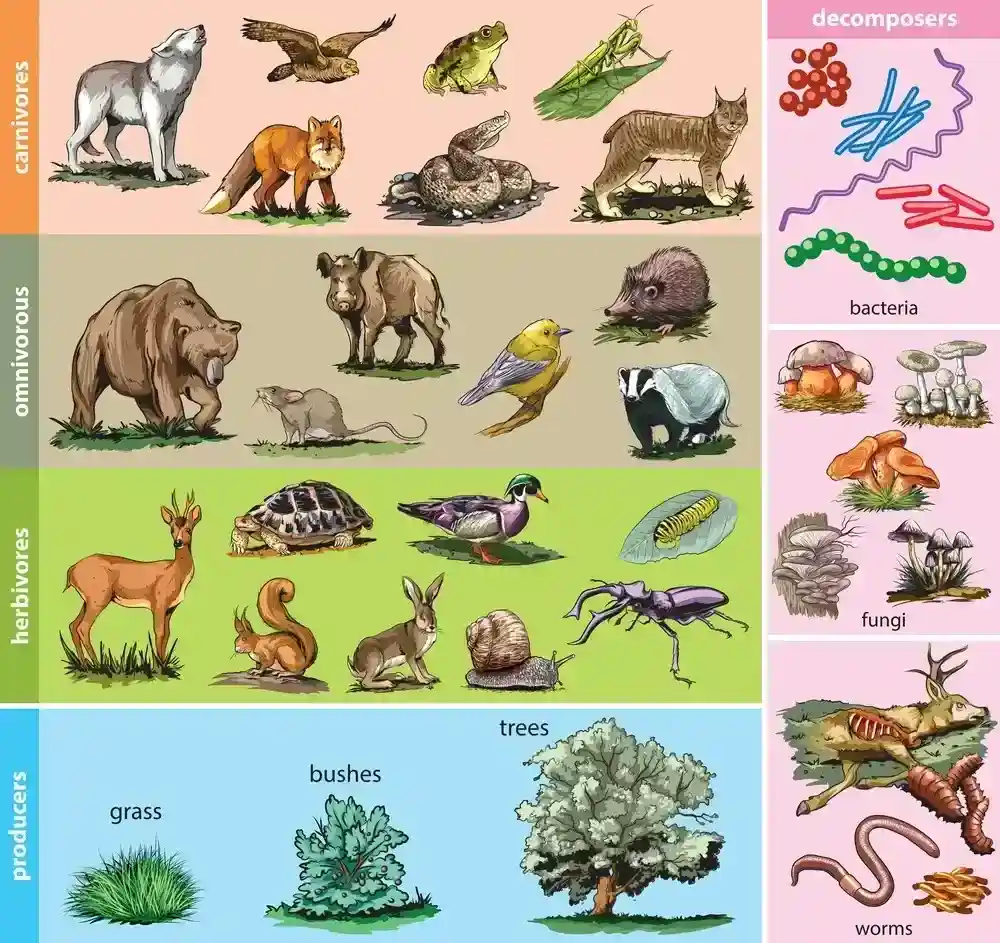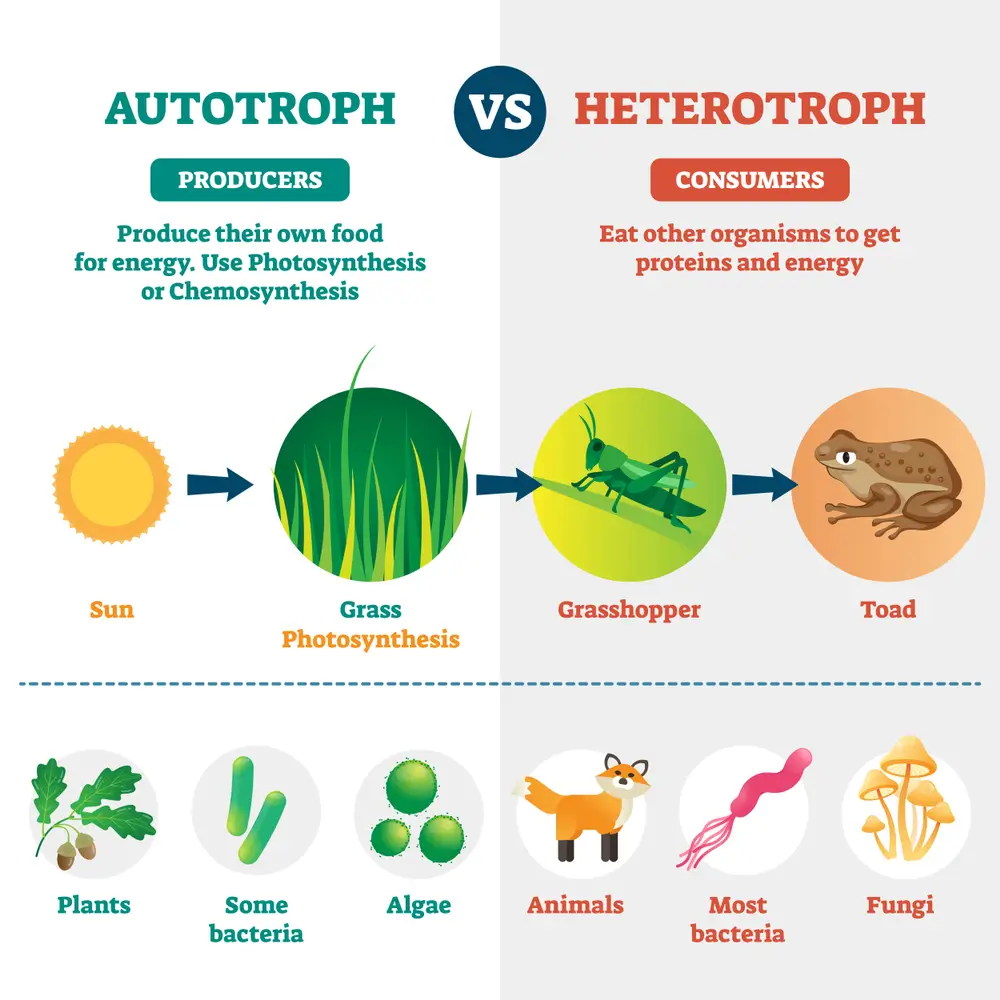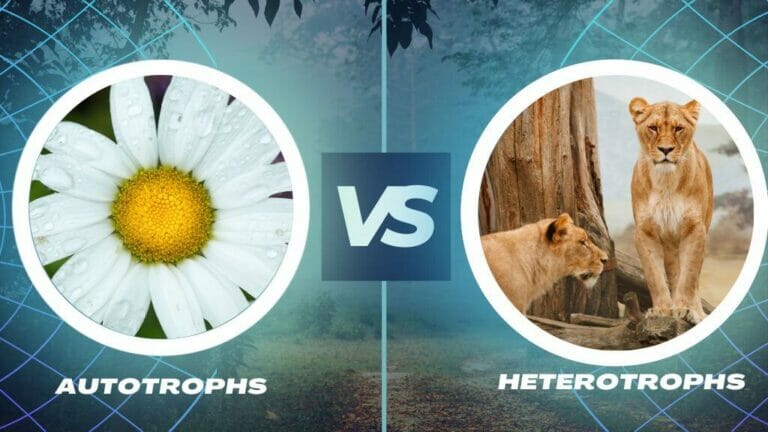The only source of energy for every living thing on Earth is food. No living thing can survive without nourishment. This food can be found in a variety of places.
According to their modes of nourishment, living things are further categorized into autotrophs and heterotrophs
The difference between autotrophs and heterotrophs is that heterotrophs are organisms that cannot prepare their food and must rely on autotrophs for sustenance.
In contrast, autotrophs prepare their food through the process of photosynthesis.
Let’s first understand the definition of autotrophs and heterotrophs for better understanding:
Table of Contents
What are Autotrophs?

An organism that can feed itself is called an autotroph, often known as a producer.
The Greek words autos, which means “self,” and trough, which means nourishment or nutrition, combine to form the English word “autotroph.”
In a food web, autotrophs are the producers, making up the bottom of an energy pyramid.
Autotrophs harness the energy of the Sun through the absurd chemical process of photosynthesis. For plants to grow, they use carbon dioxide, water, and sunlight to make sugar and oxygen.
They require energy, water, and carbon dioxide inputs. Photosynthesis is the chemical process by which plants employ these resources to produce glucose, the plant’s primary building component.
The energy for photosynthesis comes from the Sun and is sent to the ground as sunlight, producing oxygen gas as a byproduct.
Different Kinds of Autotrophs
Autotrophs come in two different kinds:
The first class of autotrophs is known as photoautotrophs, and the best example are plants, which use sunlight to perform photosynthesis.
Some types of bacteria, known as cyanobacteria and some types of algae, are both photosynthetic autotrophs.
The second type of autotroph is called a chemoautotroph, and these are often bacteria. Not all bacteria participate in this process, but some do, and they still make their food and energy.
Simply put, they don’t need sunlight; instead, they use molecules like methane in a complex chemical reaction to produce energy for them.
What are Heterotrophs?

The word heterotroph comes from the Greek words heteros, which means different or another, and trough, which means nourishment or nourishing.
A heterotroph must consume other plants and animals or decompose to obtain energy.
Cellular respiration is the mechanism by which they consume sugar and oxygen to create carbon dioxide, water, and ATP energy.
Herbivores are heterotrophs that only consume plants. Some people only consume the flesh of omnivorous animals.
Examples of Heterotrophs:
Bacteria, fungi, yeast, cows, dogs, and humans are examples of heterotrophs.
Types of Heterotrophs

There are mainly four types of Heterotrophs:
- Herbivores
- Carnivores
- Omnivores
- Decomposers
Carnivores: Carnivores are types of heterotrophs that feed on the flesh of other living things after killing them.
A fantastic example of a carnivorous heterotroph consumer is the wolf.
Herbivores: Animals classified as herbivores get all their nutrition from consuming plants.
As one of the cutest and most attractive herbivores, rabbits are a fantastic example because they only consume plant matter.
Omnivores: Omnivores are types of heterotrophs that eat both plants and animals for food.
Then there are the species that consume plants and animals; these organisms are known as omnivores.
Bears are an excellent example of omnivores because they eat a variety of foods, including fish, berries, fruits, and other animals.
Another excellent example of omnivores is humans.
Decomposers: Decomposers are animals that eat decayed and dead stuff for food.
The decomposers are a different class of heterotroph that we don’t typically think about.
Nutrients still present in an organism’s body after it has died, and decomposers can get those nutrients from dead creatures. They cause the organism to degrade.
There are two types of decomposers: the detritivores, which include earthworms, are the first to decompose.
The other group of decomposing organisms is known as saprophyte. These organisms do not consume anything; they do not have mouths or stomachs.
Instead, they absorb and release enzymes to whatever it is that they are growing; they then take those nutrients directly into their cells.
Mushrooms and fungus or a good saprophyte example.
Difference Between Autotrophs and Heterotrophs

The main differences between autotrophs and heterotrophs are given below:
The primary difference between autotrophs and heterotrophs is that they can prepare their food.
Whereas heterotrophs are unable to produce their food and must rely on outside sources.
Another difference between autotrophs and heterotrophs is that autotrophs make their own food to obtain energy.
On the other hand, heterotrophs consume other living things to get their energy.
For autotrophs, the chloroplast helps in food preparation, but heterotrophs lack chloroplast and are unable to prepare food.
Autotrophs create ecosystems, which means they supply the rest of the ecosystem’s species with energy.
In food chains and food webs, heterotrophs and autotrophs rely on one another.
Are Archaea Autotrophs or Heterotrophs?
Microorganisms with a single cell belonging to the archaea domain. They lack any organelles or cell nuclei inside of their cells.
Archaea only exist as predators or parasites of other species. Therefore, archaea are heterotrophs by nature.
Is Protista Autotrophic or Heterotrophic?
Protists are eukaryotic organisms that fall outside the definition of a fungus, animal, or plant.
Most of them have only one cell; however, some do, like algae. The huge multicellular protist known as kelp, often known as “seaweed,” gives many underwater habitats food, protection, and oxygen.
Protists can be heterotrophic, which means they get their energy from eating other living things.
Alternatively, they could be autotrophic, which means they draw their energy from the environment by using photosynthesis, which involves absorbing light energy and storing it in carbohydrates.
Although certain protists can survive on moist soil, they mostly dwell in the water. They are virtually everywhere.
What are the Differences Between Autotrophs and Heterotrophs?
Highlighting the main differences between autotrophs and heterotrophs in the following table:
| Autotrophs | Heterotrophs |
|---|---|
| Producers who prepare their own food are known as autotrophs. | Consumers who are heterotrophs rely on outside sources for their food. |
| They derive chemical energy from inorganic sources by transforming light energy. | They derive energy from other species either directly or indirectly. |
| Both chemical and light energy can be stored by autotrophs. | Heterotrophs are unable to store energy. |
| They are situated at the top of the food chain. | These are classified as secondary or tertiary foods in the food chain. |
| They are fixed in place and cannot move. | They are capable of moving around in search of food and shelter. |
| Examples of autotrophs include bacteria, algae, and green plants. | Examples of heterotrophs include cows, buffaloes, horses, and humans. |
Conclusion
There are various nutrition types of organisms: autotrophs and heterotrophs.
The difference between autotrophs and heterotrophs is that autotrophs are organisms that convert simple environmental chemicals into complex organic molecules.
The food chain’s producers are called autotrophs. Heterotrophs need organic carbon as their main source of carbon because inorganic carbon cannot be fixed by them. They use other living things as food. Their carbon source is the primary distinction between autotrophs and heterotrophs.
Learn more: What is the Difference Between Endothermic and Exothermic Reactions?


